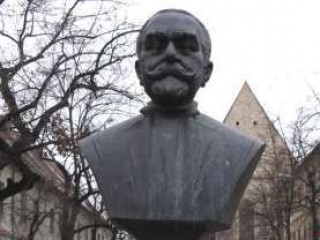
Emil Racovita (En.) biography
Date of birth : 1868-11-15
Date of death : 1947-11-17
Birthplace : Iasi, Romania
Nationality : Romanian
Category : Science and Technology
Last modified : 2011-03-31
Credited as : Biologist, zoologist, speleologist , explorer of Antarctica
0 votes so far
As a promising young scientist, Racoviţă was selected to be part of an international team that started out on a research expedition to Antarctica, aboard the ship Belgica.
On 16 August 1897, under the aegis of the Royal Society of Geography in Brussels, Belgium, the Belgica, a former Norwegian wooden whaler, left the port of Antwerp, setting sail for the South. It was the ship that gave its name to the whole expedition. The three-mast ship was equipped with a 160 horse-power engine.
The expedition was led by the Belgian officer Adrien de Gerlache, who was also the ship's owner.
The 19 members of the team were of various nationalities, a rare thing for that time. The first mate of the vessel was Roald Amundsen (who was to conquer the South Pole in 1911). Apart from Racoviţă, the team was made up of Belgian physicist Émile Danco, Polish geologist and oceanographer Henryk Arctowski with his assistant Anton Dobrowolski and American physician Frederick Cook.
The team left the deck of the ship 22 times, in order to collect scientific data, to conduct investigations and experiments. Racoviţă was the first researcher to collect botanical and zoological samples from areas beyond the Antarctic Circle.
Belgica made the first daily meteorological recordings and measurements in Antarctica, every hour, for a whole year. The scientists also collected information on oceanic currents and terrestrial magnetism, with as many as 10 volumes of scientific conclusions being published at the end of the expedition, which was considered a success.
The expedition encountered several hardships. Between March 10, 1898, and March 14, 1899, Belgica was caught between ice blocks, making it impossible to sail any further. It was a difficult year for the whole team. For instance, the crew had to carve a 75 meter-long canal through a 6 meter-thick layer of ice, in order to generate a waterway by which to sail to a navigable body of water.
Belgica returned to Europe in 1899 without two team-members, who had died during the expedition: a young Belgian mariner and Émile Danco.
Racovita's diary, published in 1899, makes mention of the difficulties that the team-members had to endure. Photos of the time show that he was hardly recognisable after returning from the expedition.
The results of his research were published in 1900, under the title La vie des animaux et des plantes dans l’Antarctique ("The life of animals and plants in Antarctica"). A year after his return, Racoviţă was appointed director of the Banyuls-sur-Mer resort and editor of the review Archives de zoologie expérimentale et générale.
Emil Racovita continued his research, contributing to speleology and exploring over 1,400 caves in France, Spain, Algeria, Italy, and Slovenia. He is considered to be, together with René Jeannel, one of the founders of biospeleology. He was particularly interested in isopoda of which he discovered many.
In 1919, Racovita became head of the Biology Department at the Upper Dacia University (now the Babeş-Bolyai University) in Cluj. He founded the world's first Speleological Institute in 26 April 1920 there, first as a section which was, however, to function independently since 1956, with professor Constantin Motas. ISER (Institutul Speologic Emil Racoviţă—Romanian for The Emil Racoviţă Speleologic Institute), a branch of the Cluj institute was open in Bucharest.
In 1920, he became a member of the Romanian Academy, and remained a major figure of scientific life in Romania until his death.
In 2006, the first Romanian Antarctic exploration station was named Law-Racoviţă.
















